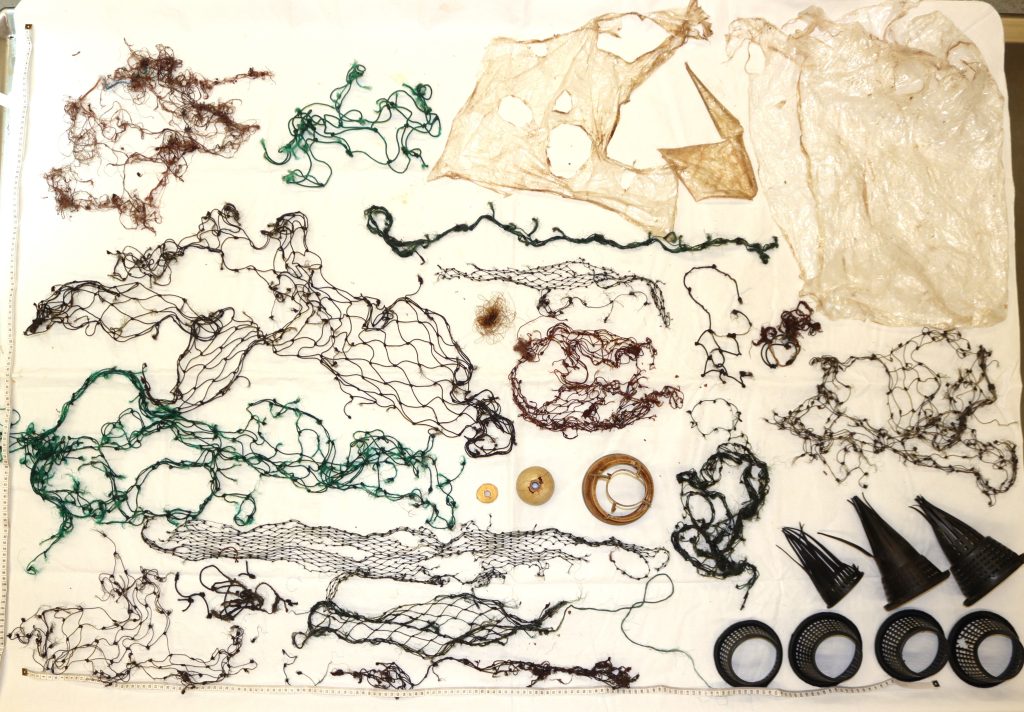02/02/23 – RESEARCHERS ARE SURPRISED AND SAD TO FIND MARINE DEBRIS IN 60-TON SPERM WHALE’S STOMACH
|
JOSH GREEN, M.D. GOVERNOR |
DAWN CHANG |
For Immediate Release: February 2, 2023
RESEARCHERS ARE SURPRISED AND SAD TO FIND MARINE DEBRIS IN 60-TON SPERM WHALE’S STOMACH
To view video please click on photo or view at this link: https://vimeo.com/795055730
(HONOLULU) – Marine debris, ingested by a 56-foot-long sperm whale, is believed to be at least a contributing cause to its death. The whale washed up on the reef fronting Lydgate Park on Kaua‘i Friday night. On Saturday, heavy equipment was used to get it onto the beach where researchers from the University of Hawaiʻi at Mānoa Health and Stranding Lab, spent 15-hours trying to find clues about its death. Their initial examination of the whale was limited because of its immense size.
“A major finding was the number of manufactured items in the whale’s stomach,” said Dr. Kristi West, the Health and Stranding Lab Director. “In addition to squid beaks, fish skeletons and other prey remains, we found at least six hagfish traps and we also found significant amounts of at least seven types of fishing net, at least two types of plastic bags, a light protector, fishing line and a float from a net. We did find a number of things in the stomach of the sperm whale that may have contributed to its death and are certainly disturbing.”
“This mammal had a huge stomach, so we were not able to examine its full expanse, which is why we think that it’s likely there was additional material we didn’t recover. The size of the opening from the intestinal tract into the stomach is relatively small and there is certainly substantial enough volume of foreign objects to cause a blockage,” West explained.
Researchers looked for signs of abnormalities to the partial organs they examined, and no irregularities were initially observed, with the exception of the gastrointestinal tract. However, they collected a number of samples from different organ systems for follow-up testing, including disease screening.
West added, “The presence of undigested fish and squid lends further evidence of a blockage. This is the first sperm whale in Hawaiian waters where we have seen this kind of ingestion of discarded fishing gear and nets.”
“These man-made items persist in the ocean for a very long time, and we hope we can learn from this. Every few days we hear about another whale, or dolphin, turtle, or monk seal entangled in fishing gear or lines. At an absolute minimum let’s prevent any more gear, plastic bags, and other items from getting into the system,” commented Edward “Luna” Kekoa, Recreational Fisheries Program Manager with the DLNR Division of Aquatic Resources (DAR).
The UH researchers found what appears to be monofilament fishing line, with three flies tied to it, which suggests all of the pollutants the whale swallowed did not originate in the ocean but came from land as well. Massive, male sperm whales transit the ocean over thousands of miles, so there’s no way to tell where the materials originated.
“We are only able to examine a small number of our dolphins and whales that die in our waters, and we think that each individual we are able to examine represents as many of 20 other animals, who are likely to ultimately die from these types of impacts. It’s heartbreaking to see this kind of destruction in an individual animal,” West said.
She added, “This was a rare and unique opportunity to document what may have contributed to the animal’s death and also to learn more about threats that sperm whales face in Hawaiian waters.”
The preliminary examination on Kaua‘i was possible because of the collaborative efforts of the County of Kauaʻi and the Office of the Mayor, DAR and the DLNR Division of Forestry and Wildlife, NOAA’s Pacific Islands Regional Office, and cultural practitioners.
Reporting deceased marine mammals
Marine mammals are culturally significant to the people of Hawaiʻi and are recognized sentinels of ocean health. An understanding of the threats faced by protected species, such as whales, is critical for effective conservation and management.
Researchers rely entirely on public reporting of marine mammals that are distressed or deceased, which is vital to understanding causes of mortality and identifying and evaluating threats to protected species in Hawaiʻi and the Pacific. The public is encouraged to report distressed, injured and dead marine mammals to the NOAA hotline 1-888-256-9840.
# # #
RESOURCES
(All images and video courtesy: Hawai‘i DLNR, unless otherwise noted)
HD video – UH Health and Stranding Lab (Feb. 1, 2023):
HD video – Kaua‘i sperm whale stranding (Jan. 28, 2023):
Photographs – UH Health and Stranding Lab (Feb. 1, 2023)
https://www.dropbox.com/sh/pym8n27ll7tzo4g/AACLLj3mkaiL33g6_zsFoL7oa?dl=0
Photographs – Sperm whale stomach contents and examination (Courtesy: UH Health and Stranding Lab):
https://www.dropbox.com/scl/fo/emo3omyrjhzqjja8hy11c/h?dl=0&rlkey=5ltiyenzm5gymr74jp8xwveb0
Photographs – Kaua‘i sperm whale stranding (Jan. 28, 2023):
https://www.dropbox.com/scl/fo/4x4ge5uvl1of19gshgjbw/h?dl=0&rlkey=i0zqna9qnycp4z3hv1rxnmvx8
Media Contacts:
Dan Dennison
Senior Communications Manager
Hawai‘i Dept. of Land and Natural Resources
(808) 587-0396
Sarah Hendrix
Content Producer
University of Hawai‘i
(808) 956-8856

